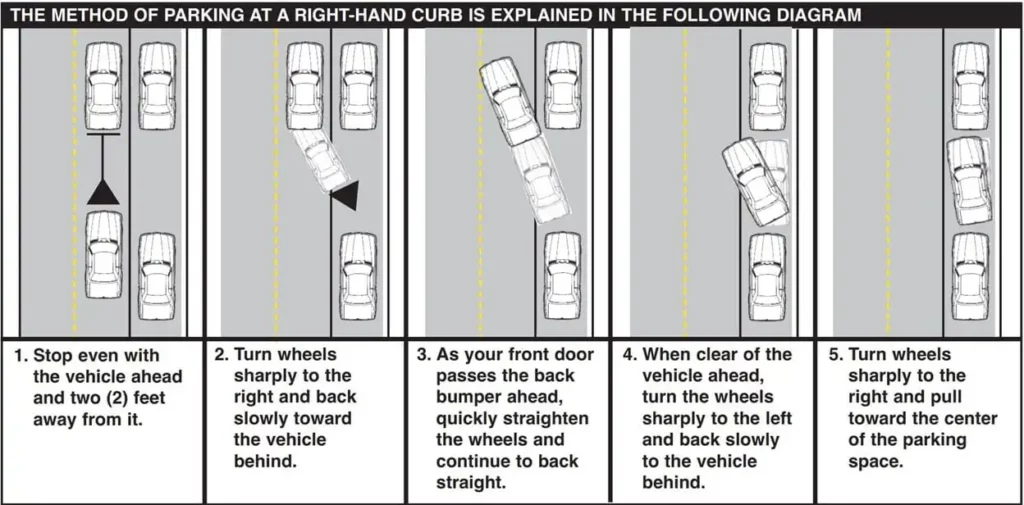Parallel parking is often the least favorite road task of anyone learning how to drive (and even for those who have been driving for years). But, with enough practice comes mastery and a greater sense of self-confidence behind the wheel.

Learning how to parallel park will not only make it easier to park when you come across tight parking spaces, but it can also help you pass your driver’s exam. In this article, we’ll look at the technique and steps involved in parallel parking so that you can pass your exam with ease and feel more confident on the road.
Understanding the Technique of Parallel Parking
Before you start practicing, it’s important to have a solid grasp of the technique behind parallel parking. Let’s break it down to a few easy tips that will help you improve your technique when learning how to parallel park.
Be consistent in your method
There are a lot of tips and tricks people will give you for parallel parking, from the triangle method to the 3-step system. It can be overwhelming to try and incorporate all of the steps when trying to park in reality – so pick a method that works for you and use it consistently every time you parallel park.
Understand the space size on the driver’s test
Some states have predetermined parking space sizes you’ll need to ace in order to pass your exam. For example, in Pennsylvania, the spot is 24 feet long and eight feet wide. Knowing this in advance can help you prepare. If you’re looking for more information, Driven2Drive includes everything you need to know about Pennsylvania’s parallel parking driving test requirements.
Practice using cones
Set up cones or clearly marked objects on a quiet street for practicing parallel parking. At first, set them up farther from each other so that you can practice the technique. Once you get more comfortable, gradually decrease the distance between the cones so you can practice parallel parking in a tighter space.
Take it easy
Parallel parking can make even the most seasoned drivers nervous, so before tackling this part of your exam, take a deep breath, remember your techniques and practices, and try not to get distracted by other things happening around you.
Get in touch with Driven2Drive to book a package of driving lessons
The 10 Steps Involved in Parallel Parking
While it may seem like parallel parking has a lot of steps, once you get the hang of it, it will become second nature. Here’s a breakdown of the steps to keep in mind to help you learn to parallel park.
1. Find a parking spot
This may seem simple, but depending on where you’re parking, this can be the toughest part! If you’re in a busy area, finding a spot to park that will fit your car can be tricky, so a little patience goes a long way. If you find a spot but it feels too tight or the road behind you is too busy, move on to the next one. It’s better to park somewhere when you feel safe and calm in your surroundings.
2. Signal your intention
Once you’ve found a spot that’s the right size, put on your turn signal to indicate to drivers behind you that you’re about to parallel park so that they can go around you if necessary.
3. Position the car
Position your car so that it’s parallel to the car in front of the empty space. Your front bumpers should be aligned and there should be around 2-3 feet of space between your car and the parked car.
4. Check your mirrors
Before moving the car any further, check your rear-view mirror to make sure there aren’t any cars, cyclists, or pedestrians behind you, and check your side mirrors to make sure there are no obstacles in your blind spots.
5. Start reversing the car
Before you release your foot from the brake, turn your steering wheel almost fully to the right (or left, depending on where you’re parking). Slowly and with care, release the brake so your car starts reversing at a 45-degree angle.
6. Straighten the steering wheel
The back of your car should be mostly in the parking spot, but it shouldn’t be too close to the curb or the car behind you. If it is, you’ll need to restart. If you’re at a safe distance, straighten the steering wheel and continue reversing. Remember to continuously check your mirrors, blind spots, and around your car.
7. Turn your steering wheel the other way
Once the front bumper of your car passes the back bumper of the car parked in front of you, you’ll need to turn the steering wheel in the other direction. If you were maneuvering right, then turn your wheel to the left and continue backing up slowly.
8. Check how close you are
Take a moment to assess how close you are to the car in front of you, behind you, and the curb beside you. If necessary, readjust before continuing. If you have space, straighten out your wheels and reverse slowly toward the vehicle behind you.
9. Adjust position if needed
Always make sure you’re leaving enough space for the cars in front and behind you to get out. Check your position and, if necessary, pull the car forward or backward to leave more space.
10. Smile!
Give yourself a pat on the back for that amazing job parallel parking. Nearly half of American drivers have parallelophobia – or the fear of parallel parking – so mastering this skill is no small feat!

Passing your parallel parking test
Before getting yourself worked up over passing parallel parking on your driving test, it’s important to realize that parking requirements on tests may differ from state to state. Here are some things to be aware of.
Parallel parking isn’t a requirement on all driving exams
Now’s the time to breathe a sigh of relief! Well, depending on where you live. While parallel parking is a skill you need to know for your driving test in many states, such as Pennsylvania, there are some states where it isn’t a requirement. The following states don’t require parallel parking to pass a driver’s exam:
- Alabama
- Arkansas
- California
- Colorado
- Florida
- Illinois
- Maryland
- Nebraska
- North Carolina
- Ohio
- Oregon
- South Dakota
- Tennessee
- Virginia
- Wyoming
That said, it’s always a good idea to still practice parallel parking to sharpen your driving skills.
Some states have different tests instead of parallel parking
Rather than making students parallel park on a road while already in a stressful situation, some states like Ohio have maneuverability tests on the exam that use similar skills. Always be sure to check with a driving school or your local DMV to understand the requirements to pass an exam.
Learning Parallel Parking with Driven2Drive Premier Driving School
Reading about how to parallel park is great for understanding the concept, but the best way to pick up this skill is through real-world practice. Driven2Drive offers driving lessons in Pennsylvania that help you learn all the skills you need to succeed on your Road Test, especially when it comes to parallel parking. Our team can help you better grasp the theory of parallel parking and pair it with road practice so that you can master this skill.
Schedule your road test now with Driven2Drive
FAQs
What to look for in your mirrors when parallel parking?
When parallel parking, you should use your rear-view and side mirrors before moving the vehicle in order to check that there are no obstacles around you. While reversing, your rear-view mirror should be used to check the distance of the car behind you and your side mirrors can help you ensure you don’t hit the curb as well as the car behind you.
What is the secret to parallel parking?
Trust us, if there was a secret trick, we’d know! Aside from following the steps outlined above, there’s no big secret. The easiest way to parallel park is to understand the theory and practice as much as possible.
How do you do the parallel park triangle trick?
A trick some drivers use when parallel parking is using the small, triangular window on the back of your car to assess when you’re in the right position to start turning your wheel and reverse.

Ronit Tehrani is the Founder and Co-Owner of Driven2Drive, a premier driving and license testing center in Philadelphia. Since 2013, she has been dedicated to providing safe driving education and skills for lifelong success. Under her leadership, Driven2Drive became Pennsylvania’s first privately owned PennDOT-certified testing center, now with six locations.
